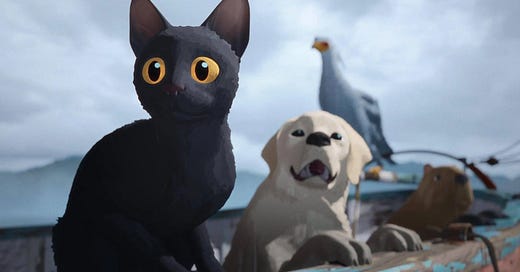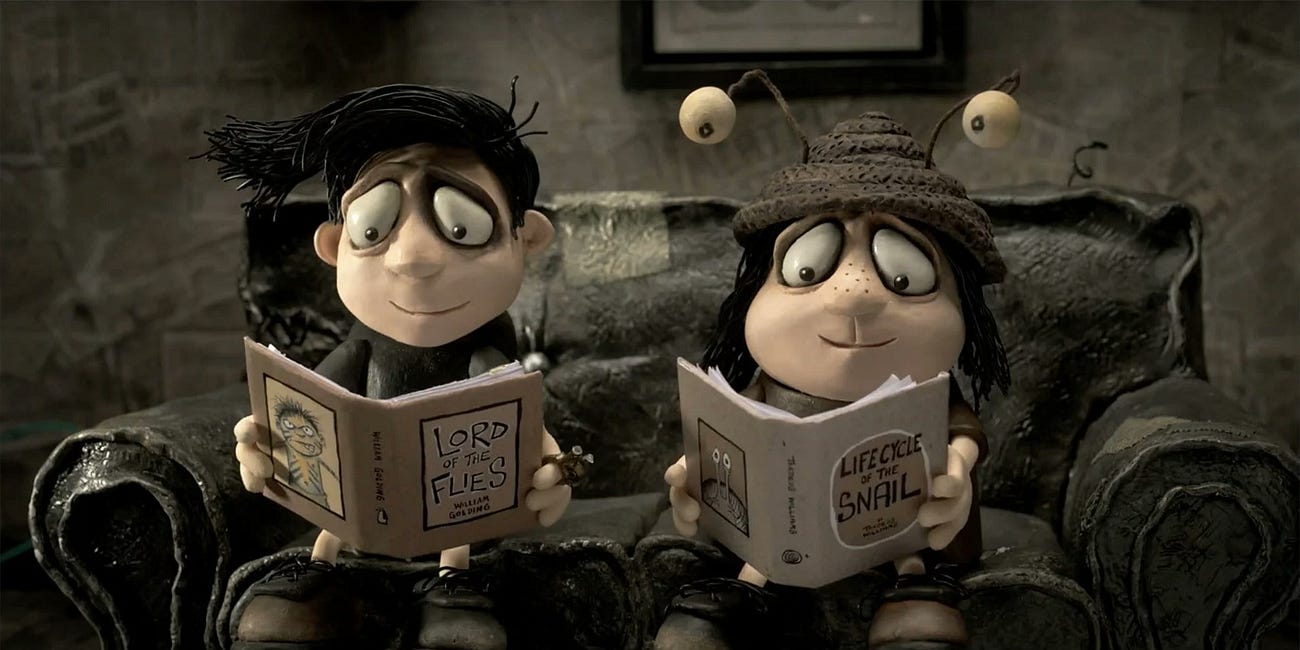MOVIE REVIEW: Flow (Dir. Gints Zilbalodis, 2024)
"Believe me, my young friend, there is nothing - absolutely nothing - half so much worth doing as simply messing about in boats." (The Wind in the Willows, Kenneth Grahame)
What do: a cat, a golden retriever, a capybara, a ring-tailed lemur, and a secretary bird have in common? Gints Zilbalodis’s new animated feature film, Flow (2024), brings these animals together in a desperate fight for survival against the rising tides. While the lack of any dialogue may raise concerns for any parent considering taking their children to the cinema over the next few weeks, I believe that to overlook Flow is to overlook the standout family film of 2025 so far.
Produced over the course of five years using exclusively free and open source animation technology, Flow is a testament the crafty ingenuity and willingness to experiment which has defined the animation scene over the last decade. The film follows the adventures of a cat, unnamed within the fiction (for obvious reasons), but whom I had internalised as being both, female, and the eponymous Flow, as they find themselves caught in a flood of biblical proportions. Finding their way onto a boat piloted by an incredulous capybara, the pair assemble a rag tag crew as they float throughout the many landscapes of the film in search of dry land. It moves quite unlike any film I expect we will see this year, exploratory and curious against an imposing and tensely silent world. The humans, or humanoids (given that the film’s setting is more Earth-like than Earth), have all vanished. What remains is the emptied out structures of what used to be civilisation. European, Greco-Roman/Venetian, and East Asian inspired architecture litter the landscape as hollow reminders that something, at some point, existed here, and that they built these things with a purpose. The animals, for their part, are indifferent to all of this. They have their own concerns, their own intricate social structures and dynamics that the film loves to cast its gaze over before turning away, hesitant to reveal too much.
If you read more in depth looks into, Flow’s, production, such as Alex Dudock De Wit’s interview with Zilbalodis in the April 2025 issue of Sight and Sound, you will notice that everyone is talking about the way the camera moves in the film. And rightly so, it is as striking and as full of character as everything else in the movie. Contrary to how you might think, Flow is not the product of meticulous planning and storyboarding. By Zilbalodis’s own admission he prefers to work on the instinctual level rather than as a filmmaker who can articulate exactly what they want ahead of time. Much of the film was composed after the landscapes had already been digitally designed, and from there Zilbalodis would discover ways to navigate them with the camera. This is where much of the film’s spontaneous visual style emerges from, the camera is as much at play in the discovery of the world as the animals themselves. The live action comparisons, Alfonso Cuaron (Children of Men, Harry Potter and the Prisoner of Azkaban), Alejandro Iñarritu (Birdman, The Revenant), and Mikhail Kalatozov (I Am Cuba, The Cranes Are Flying) that have been drawn speak to exactly what the viewer gets from the film: long, expansive tracking shots which move across boundaries to show the relationships of our characters to the scale of the world beyond them. Zilbalodis never shoots anything in the film that escapes the realm of naturalism, but it is breathtaking to watch as the camera moves from the tip of the boat’s sail, to its crew in the interior, to skimming the edge of the water before descending to show the audience the great beasts which lurk underneath the flood. It mimics the movement of the animals but expands beyond them to show just how small they are in relation to the much greater whole of the world. If Flow is a film that was found in the act of its own making, then what is reflected on the screen is the discovery of the world in the act of viewing.
In terms of art style, I will be the first to admit that I am not the most qualified to discuss the prevailing trends of 3D animation. Given the nature of the software used: Blender, the film did evoke more memories of video games than of cinema. As video games are not an area I am as well-versed in, I will do my best to elucidate what they mean. The most obvious point of comparison seems to be the 2022 game, Stray, also about a cat living in a human-less Kowloon Walled City. Yet the sense of scale also reminded me of the 2023 climb-’em-up game, Jusant, with its long meditations on the interconnectivity of man and nature. What the film does wonderfully is manage to animate the animals at the core of the story in such a way that they seem both as they are in life, and, full of expressive mannerisms. Every animal is distinct from one another. You understand every bit of thought and emotion felt by our cat protagonist. I almost gasped when I saw the way the lemur was only able to take its eyes away from the mirror, only offering a second of acknowledgement to the cat before looking right back into the mirror, exactly how my own dog interacts with me when she is looking out of the living room window. If I had a single gripe with the animation it would be that I would have liked the foliage to react more with the animals passing over it, but this is the nit-pick to end all nit-picks. For a team as small as Flow’s, using the resources they did, I understand that I am simply demanding more from something already achieving the seemingly impossible.
I have long been an advocate of the idea that children need (and want, whether they know so or not) exposure to art of a high quality. Not only does it enrich their culture, but it exposes their curious minds to the possibility that the future is brimming with infinite potential for new ideas. Flow, is a space for families to explore truly breathtaking, forward thinking art which both challenges and nourishes. That is why I think that, Flow, is important, and why I hope that it will prove to be an important cornerstone for a generation of artists and thinkers in the coming decades.
Ryan Sweeney (@thecautiouscrip / Insta: teawithzizek)
If you liked this review, why not check out my review of fellow best animated feature nominee: Memoir of a Snail
MOVIE REVIEW: Memoir of a Snail (dir. Adam Elliot, 2025)
Memoir of a Snail, the latest feature from claymation heartbreak maestro, Adam Elliot (Mary and Max, Harvie Krumpet) is obviously a mini-marvel of a film. A painstakingly handcrafted world that exists on an aesthetic axis between the ghoulish creatures inside Lon Chaney’s mind and





